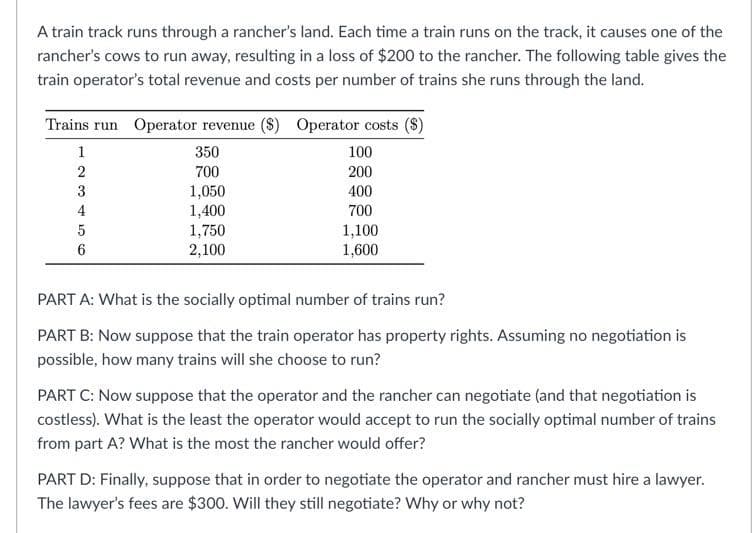A train track runs through a rancher's land. Each time a train runs on the track, it causes one of the rancher's cows to run away, resulting in a loss of $200 to the rancher. The following table gives the train operator's total revenue and costs per number of trains she runs through the land. Trains run Operator revenue ($) Operator costs ($) 350 700 1,050 1,400 1,750 2,100 100 200 1 3 400 4 700 1,100 1,600 6. PART A: What is the socially optimal number of trains run? PART B: Now suppose that the train operator has property rights. Assuming no negotiation is possible, how many trains will she choose to run? PART C: Now suppose that the operator and the rancher can negotiate (and that negotiation is costless). What is the least the operator would accept to run the socially optimal number of trains from part A? What is the most the rancher would offer?
A train track runs through a rancher's land. Each time a train runs on the track, it causes one of the rancher's cows to run away, resulting in a loss of $200 to the rancher. The following table gives the train operator's total revenue and costs per number of trains she runs through the land. Trains run Operator revenue ($) Operator costs ($) 350 700 1,050 1,400 1,750 2,100 100 200 1 3 400 4 700 1,100 1,600 6. PART A: What is the socially optimal number of trains run? PART B: Now suppose that the train operator has property rights. Assuming no negotiation is possible, how many trains will she choose to run? PART C: Now suppose that the operator and the rancher can negotiate (and that negotiation is costless). What is the least the operator would accept to run the socially optimal number of trains from part A? What is the most the rancher would offer?
Practical Management Science
6th Edition
ISBN:9781337406659
Author:WINSTON, Wayne L.
Publisher:WINSTON, Wayne L.
Chapter4: Linear Programming Models
Section: Chapter Questions
Problem 82P
Related questions
Question
!

Transcribed Image Text:A train track runs through a rancher's land. Each time a train runs on the track, it causes one of the
rancher's cows to run away, resulting in a loss of $200 to the rancher. The following table gives the
train operator's total revenue and costs per number of trains she runs through the land.
Trains run Operator revenue ($) Operator costs
1
350
100
700
200
3
1,050
1,400
400
4
700
1,750
2,100
1,100
1,600
5
6
PART A: What is the socially optimal number of trains run?
PART B: Now suppose that the train operator has property rights. Assuming no negotiation is
possible, how many trains will she choose to run?
PART C: Now suppose that the operator and the rancher can negotiate (and that negotiation is
costless). What is the least the operator would accept to run the socially optimal number of trains
from part A? What is the most the rancher would offer?
PART D: Finally, suppose that in order to negotiate the operator and rancher must hire a lawyer.
The lawyer's fees are $300. Will they still negotiate? Why or why not?
Expert Solution
This question has been solved!
Explore an expertly crafted, step-by-step solution for a thorough understanding of key concepts.
Step by step
Solved in 2 steps

Recommended textbooks for you

Practical Management Science
Operations Management
ISBN:
9781337406659
Author:
WINSTON, Wayne L.
Publisher:
Cengage,

Practical Management Science
Operations Management
ISBN:
9781337406659
Author:
WINSTON, Wayne L.
Publisher:
Cengage,